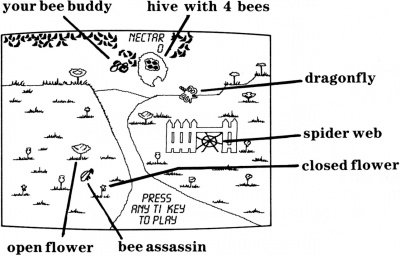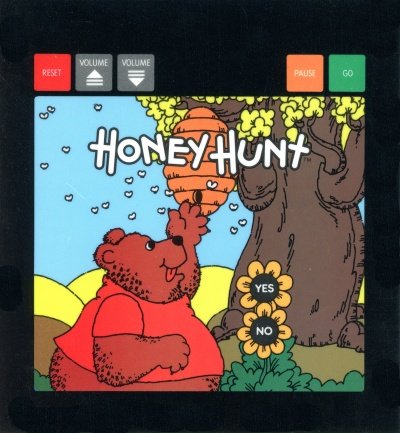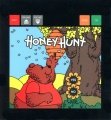Honey Hunt
Honey Hunt is an action/educational software created by Milton Bradley for the TI-99/4A home computer system. Honey Hunt requires the Solid State SpeechTM Synthesizer, and can optionally use the Milton Bradley MBX System. It was programmed by Tim Scully. It was released as part number PHM 3156 during the fourth quarter of 1983 for a retail price of $49.95 (USD).
| Honey Hunt | |
|---|---|
 | |
| Publisher(s) | Milton Bradley |
| Original Retail Price | $49.95 (USD) |
| Programmer(s) | Tim Scully |
| Part# | PHM 3156 |
| Format(s) | Solid State SoftwareTM Command Module |
| Release | 1983 (4th Quarter) |
| Genre(s) | Action, Educational |
Contents
[hide]- 1 Gameplay
- 2 Advertising Blurb
- 3 Fun Fact
- 4 Manual
- 5 Downloads
- 6 References
- 7 External Links
Gameplay
Honey Hunt is a simple children's game. The player moves the bee from the hive onto open flowers in order to gather nectar. Then, the player returns the nectar to the hive to make honey. The bee, however, has various enemies trying to destroy the bee causing the player to lose a life. The enemies include spiders with sticky spider webs, dragonflies, and bee assassins. The hive is the safety zone for the player. To escape from enemies, the player can move off the edge of the screen and then reappear on the opposite edge while enemies cannot accomplish this maneuver. The player also has to be wary of the honey-hungry bear who attempts to steal honey from the hive. In moving the bee, the player can use either the MBX system joystick, a regular TI-99/4A approved joystick or the keyboard.
Advertising Blurb
Front Cover of Manual
Prediction and patterning skills for "bee-ginners."
Fun Fact
Honey Hunt was originally developed by Milton Bradley for its own video gaming system. Eventually, Milton Bradley scrapped efforts to produce their own video games console, and instead, created the MBX add-on system for the TI-99/4A. The games originally created for the Milton Bradley system were eventually ported over to the TI-99/4A instead.
Manual
Note to Parents
Milton Bradley and Texas Instruments, two companies that create entertaining and educational products for your child, work together to bring you Bright Beginnings™ games. Bright Beginnings is a special software series that allows your child to discover, explore, and learn. Milton Bradley and Texas Instruments believe that video activities should do more than bring bright smiles-they should also bring bright ideas. That's why Bright Beginnings combines fun and learning so successfully.
The Bright Beginnings cartridges are designed to be age appropriate, introducing the proper learning tool at the right time in your child's life. The games encourage your child to interact with the computer as creatively as possible through exploratory learning activities.
There's something special in Bright Beginnings for you, the parent. Included in this instruction booklet is a Discovery Guide that tells you exactly what learning skills your child is developing. The Discovery Guide also goes one step further and suggests additional related activities that you and your child can do together. All of the activities include helpful hints on how to encourage your child to develop learning skills by exploring his or her environment.
Honey Hunt was developed by Joyce Hakansson Associates Inc., an independent production company. The JHA approach to fun and learning blends excellence from a number of disciplines. Their design team consists of artists, writers, musicians, child development experts, programmers, and an academic advisory board all working together to create interactive learning games that build on your child's inherent love of play.
The Theme of the Game
Discovering when events occur is what Honey Hunt, a game of skill and strategy, is all about. When playing, have your child look carefully at all the suspenseful events that occur in the meadow and see if he or she can recognize a certain pattern in them. Your child can polish up his or her prediction skills and score points, too!
Your child helps bee friends collect nectar drops from flowers (ones with open petals). He or she can control the bee's movement with either the MBXjoystick, the TI Joystick Controllers, or the TI keyboard. Each nectar drop he or she collects is worth points. Your child avoids a dangling spider and its sticky web, and other uninvited guests in the meadow (like a big bear with a sweet tooth for honey and a dragonfly that dives and darts all over).
Have your child watch the screen closely, listen to the delightful music and sound effects, and try to discover what happens when on the Honey Hunt.
Two Ways to Play Honey Hunt
This Honey Hunt cartridge can be played with the Texas Instruments Home Computer or with the Texas Instruments Home Computer and the MBX Expansion System. The MBX Expansion System adds new dimensions to your Texas Instruments Home Computer. This booklet contains instructions for using both systems. Instructions for each method are separated by a bar format. The first bar, which is color coded in blue, tells you how to play the game with your MBX Expansion System. The second bar tells you how to play the game with your Texas Instruments Home Computer alone.
TI Home Computer with the MBX Expansion System
The MBX console plugs into your Texas Instruments Home Computer. Refer to the set-up instructions in your MBX Expansion System booklet to properly connect the systems.
Here's What the MBX Expansion System Includes
- MBX console with built-in action keypad
- Triple-axis analog joystick
- Headset microphone (not used with this cartridge)
- Power supply
- Fully-illustrated instruction booklet
Playing Honey Hunt with the MBX Expansion System
- Triple-axis analog joystick allows total maneuverability of screen objects.
- Action-input keypad with its own colorful overlay allows for quick response and flexible play.
- Speech Synthesis allows you to hear phrases, prompts, and sound effects that are true-to-life, well-modulated, and full of inflection.
TI Home Computer without the MBX Expansion System
- You can play Honey Hunt and control all the action on the screen with the Texas Instruments Joystick Controllers (sold separately) or the Texas Instruments computer keyboard or a combination of both.
- Speech makes the game more exciting. You need the Texas Instruments Solid State SpeechTM Synthesizer (sold separately) to activate speech capabilities.
Getting Started
After the cartridge title screen appears, your child sees a short demonstration of game play. This is the DEMO MODE. He or she can sit back and watch all the action. After the DEMO MODE, the computer asks if your child wants screen instructions. Read the instructions below for the system you are using.
TI Home Computer with the MBX System
- After viewing the DEMO MODE, the message, TO START PRESS GO appears. Have your child press GO on the MBX console. The title screen and DEMO MODE continue to replay if the proper key is not pressed. If the title screen reappears, your child presses any key on the TI computer keyboard to reach the instruction option screen. If the DEMO MODE reappears, your child presses the GO key on the MBX console to reach the instruction option screen.
- When the message DO YOU WANT INSTRUCTIONS? appears, have your child:
- Press YES on the MBX console for step-by-step instructions. He or she can follow all the directions on the screen and then press the TRIGGER button on the MBX joystick to start the game.
- Press NO on the MBX console to bypass the instructions and start the game.
TI Home Computer without the MBX System
- After viewing the DEMO MODE, the message, PRESS ANY TI KEY TO PLAY appears. Have your child press any key on the TI computer keyboard to reach the instruction option screen. The title screen and DEMO MODE continue to replay if a TI key is not pressed.
- When the message DO YOU WANT INSTRUCTIONS? appears, have your child:
- Press Y on the TI keyboard for step-by-step screen instructions. He or she can follow all the directions on the screen. Then, to start the game, press the FIRE button on the Joystick Controller; or press the Q key or the SPACEBAR on the TI computer keyboard.
- Press N on the TI computer keyboard to bypass the instructions and start the game.
Playing the Game
In Honey Hunt, your child tries to land a bee buddy on an open flower to gather a nectar drop. When he or she returns the bee to its hive with the drop of nectar, points are earned. Your child begins the game with five bees at home in the hive. Follow the instructions below for the system you or your child is using.
Moving the Bee and Collecting Nectar
Your child moves the bee onto open flower petals to collect nectar drops. Your child can move the bee to as many flowers as he or she wishes, but cannot receive points unless the nectar drop is taken to the bee's hive.
TI Home Computer with the MBX System
- Have your child move the MBXjoystick in the desired direction to move the bee.
TI Home Computer without the MBX System
- Have your child move the lever of the Joystick Controller to move the bee in the desired direction or use the arrow keys on the TI computer keyboard.
- Left Side of the Keyboard
- Press E (↑) to move bee up, X (↓) for down, S (←) for left, D (→) for right, W (↖) for diagonal (upper left), R (↗) for diagonal (upper right), C (↘) for diagonal (lower right), or Z (↙) for diagonal (lower left).
- Right Side of the Keyboard
- Press I (↑) for up, M (↓) for down, J (←) for left, K (→) for right, U (↖) for diagonal (upper left), O (↗) for diagonal (upper right), , (↘) for diagonal (lower right), or N (↙) for diagonal (lower left).
Note: The ALPHA LOCK must be in the OFF (up) position when playing with the Joystick Controllers.
The Bee's Enemies
The bee has three enemies: spiders and sticky webs, dragonflies, and bee assassins. Your child can move the bee to escape these hungry creatures and deliver the drop of nectar to the hive safely. If the bee is caught by one of these creatures, the bee is lost. Watch out for a honey-hungry bear, too, for he tries to steal honey from the hive!
Defending Bees
- The beehive is a safety zone; have your child move the bee to its hive when being attacked by an enemy.
- Have your child move the bee to the far right or left side of the screen to escape an enemy; the bee disappears from the screen and reappears on the opposite side of exit.
Losing Bees
If your child's bee is caught by an enemy, he or she loses that bee. If your child has bees left in the hive, play continues. If he or she does not have any bees left in the hive, the game ends.
If your child loses a bee and wants to bring another bee into play from the hive, have him or her follow the instructions below for the system you or your child is using.
TI Home Computer with the MBX System
- Have your child press the TRIGGER button on the MBXjoystick.
- Next, your child can move the bee from the hive to find another open flower petal.
TI Home Computer without the MBX System
- Have your child press the FIRE button on the Joystick Controller. He or she can also press the SPACEBAR, the Q key, or the Y key on the TI computer keyboard.
- Next, your child can move the bee from the hive to find another open flower petal.
The Big Furry Bear
The bear raids your child's hive if it is left unattended! Your child can hear the bear approaching when the bear says TIME TO GET THE HONEY. To save the honey, do the following for the system you're using.
TI Home Computer with the MBX System
- Quickly get the bee back to the hive by using the MBX joystick.
TI Home Computer without the MBX System
- Quickly get the bee back to the hive by moving the lever on the Joystick Controller. You may also use the arrow keys on the left side of the TI computer keyboard, or the (←) J, (→) K, (↑) I, or (↓) M keys on the right side of the TI computer keyboard.
Scoring, Strategy Hints, and Ending the Game
Your child earns points for each nectar drop collected. Explain the strategy hints to your child on how to outwit the bee's enemies.
Scoring
Each time your child returns a bee to its hive with a nectar drop, he or she gains points. A running total of points appears on the screen.
Your child receives 10 points for each nectar drop he or she collects. After your child accumulates 500 points, he or she earns 20 points for each nectar drop collected.
Strategy Hints
- Your child's score determines when the enemies appear on the screen. So watch your point total to predict a predator's entrance to the meadow.
- A bear will first appear when your child earns 250 points, only then will he or she have to guard the hive!
Ending the Game
The game ends when your child loses all five bees. If your child wishes to play again, have him or her follow the instructions given below for starting a new game.
TI Home Computer with the MBX System
When the message GAME OVER. PRESS GO OR RESET appears, have your child press GO on the MBX console to play again bypassing the DEMO MODE and the instructions; or have your child press RESET on the MBX console to play again returning to the instruction option screen.
TI Home Computer without the MBX System
When the message GAME OVER. PRESS REDO OR BACK appears, have your child press REDO on the TI keyboard to play again bypassing the DEMO MODE and the instructions; or have your child press BACK on the TI keyboard to play again returning to the instruction option screen.
Discovery Guide
As children play Honey Hunt, they imaginatively enter an environment that invites them to develop the learning skills of prediction and pattern recognition. Children develop increasingly complex game strategies while playing in a world that is based on a realistic setting. They fly a bee from flower to flower to collect nectar, increasing their proficiency and adding points to their score.
Several interrelated patterns are built into Honey Hunt; flowers, dragonflies, and webs. Most children build individual strategies around these sequences in order to gather nectar. Older children may notice a connection between the predators' appearance and their own point score or competence: When you get really good, the dragonfly comes back. Older children may use their math skills to predict their scores. They begin counting flowers and multiplying by tens: You've got 80. If you get two more flowers, you '11 have a hundred.
Younger children, however, are intrigued by the sense of mastery they feel while directing the bees; they do not concentrate on their point scores. This mastery can become a crucial element in a child's game strategy. Some children may choose to play Honey Hunt by deliberately flying each bee into the spider web to see the consequences and to listen to the music.
Honey Hunt builds on your child's inherent curiosity of the world around him or her. The game environment introduces the insect world to him or her within the non-threatening context of imaginative play. The screen represents a natural setting, presenting creatures that can all be encountered in the real world.
Once you and your child have begun to explore what Honey Hunt has to tell you about pattern recognition and prediction skills, why not go one step further...
Take It One Step Further
There are a number of ways you can determine the manner in which your child develops a play strategy with Honey Hunt. Ask your child what he or she thinks the spider, dragonfly, or bear will do when they appear on the screen. Ask your child to predict when each of these creatures will appear, where they will appear, or which flower will open next. Ask your child if he or she can think of a way to collect nectar while avoiding the predator. If he or she has well-developed math skills, ask how many flowers the bee needs to collect in order to reach a particular point score.
Help your child collect and press flowers by placing them between sheets of tissue paper within the pages of a large book. You can help young children sort the flowers by color, shape, and size. Older children might enjoy looking up the names of the flowers in their collections in nature books.
If you have vases of flowers in your house, point out to your child how and when the blossoms open and close.
You can reinforce the concepts of open and closed with young children by playing a simple guessing game. Hide a penny in one hand, then present both hands closed to your child and let him or her guess which one holds the penny.



